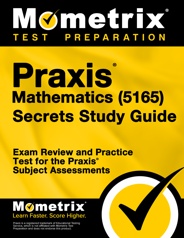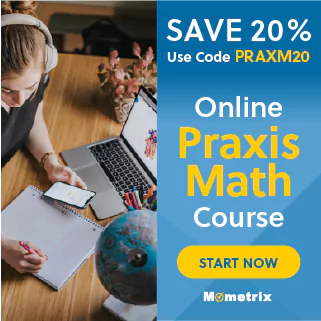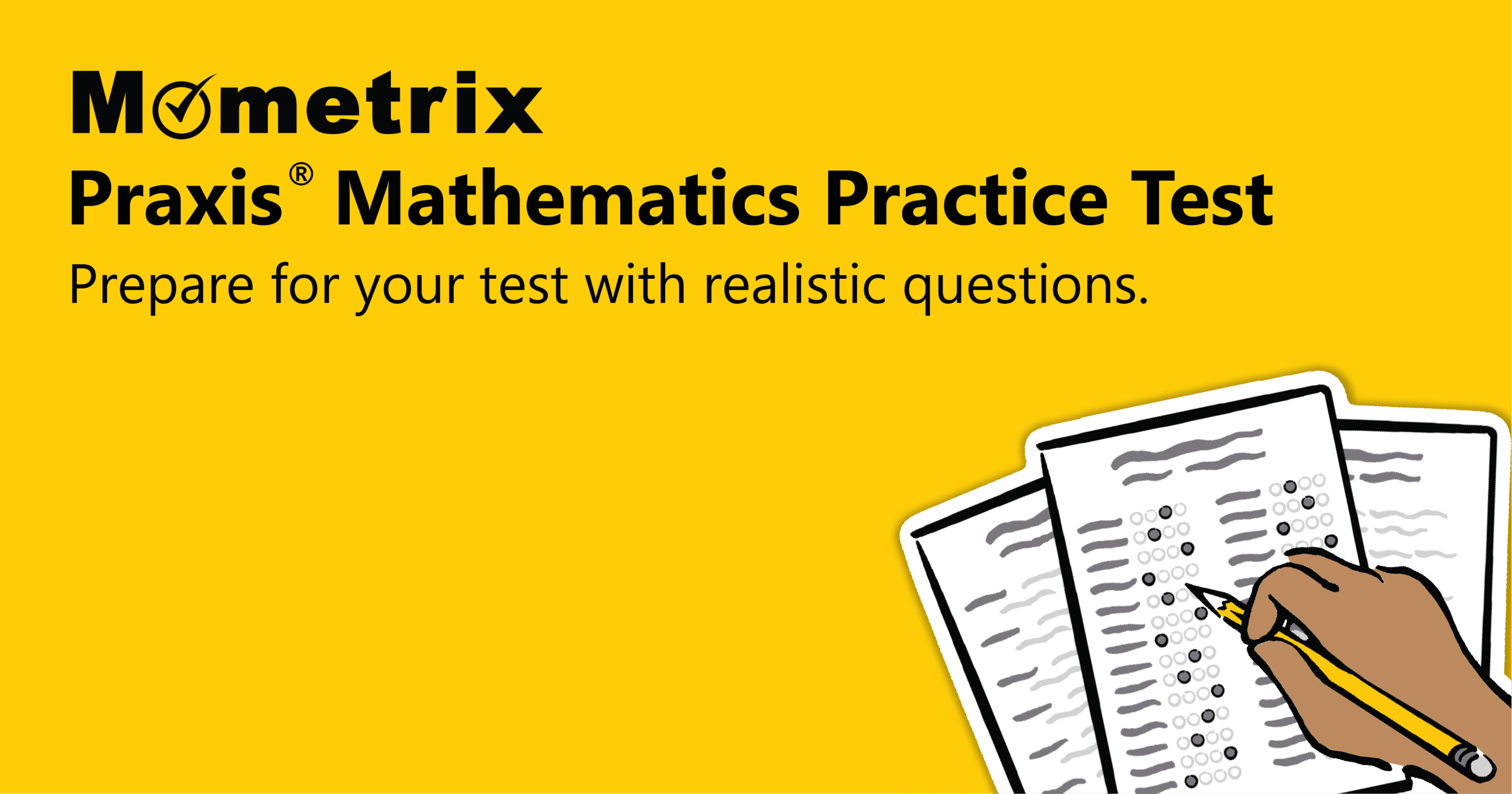The Praxis® Mathematics exam is a test used to evaluate the knowledge and skills of prospective Mathematics teachers for secondary school.
Click “Start Test” above to take a free Praxis Mathematics practice test!
Taking the Praxis Core Math exam? Click below to learn more:
Praxis Math Exam Outline
The Praxis Mathematics exam contains 66 selected-response questions and has a time limit of 3 hours. There are several different forms of selected-response questions, any combination of which may appear on the exam:
- Drag-and-drop
- Single-selection multiple-choice
- Drop-down
- Numeric entry
- Sentence selection
- Hot spot
The exam is organized into four content categories.
I. Number and Quantity and Algebra (20 questions)
The questions in this category cover the following topics:
- The structure of the real number system
- Performing basic operations with real numbers
- The properties of radicals and rational exponents
- Quantitative reasoning
- Using units to solve problems
- The structure of the complex number system
- Performing basic operations with complex numbers
- Writing algebraic expressions in equivalent terms
- Equations and inequalities that describe relationships
- Solving equations and inequalities using various techniques
- Solve systems of equations and inequalities using various techniques
- Rate of change of nonlinear functions
- Linear equations presented in various forms
- The relationship between zeros of polynomial functions and factors of the related polynomial expressions
- Rewriting rational expressions
- Justifying the reasoning process for solving equations
II. Functions and Calculus (20 questions)
The questions in this category cover the following topics:
- Function notation
- Various representations of function behavior
- Modeling relationships between quantities using functions and relations
- Obtaining new functions from existing functions
- The differences among quadratic, linear, and exponential models
- Using logarithms to solve problems
- The relationship between points and the unit circle and the values of trigonometric functions
- Using trigonometric functions to model periodic phenomena
- Solving logarithmic, trigonometric, and exponential equations
- Limited functions
- Calculating the limits of functions
- The derivative of a function as a limit, rate of change, and/or slope of a line tangent to a curve
- The relationship between differentiability and continuity
- Continuous points of a function
- Standard differentiation and integration techniques
- Function behaviors
III. Geometry (13 questions)
The questions in this category cover the following topics:
- The properties of lines
- The properties of various polygons
- Transformations within a plane
- Congruence
- Similarity
- Proving geometric theorems
- Applying trigonometry to triangles
- Applying theorems about circles
- Describing properties of geometric objects using coordinate geometry
- Solving problems involving perimeter and area of polygons
- Solving problems involving solids
IV. Statistics and Probability (13 questions)
The questions in this category cover the following topics:
- Making inferences
- Justifying conclusions
- Interpreting, summarizing, and representing data
- Creating and interpreting linear regression models
- The concept of independence
- Computing probabilities of simple, compound, and conditional, events
- Finding probabilities involving independent trials and finite sample spaces
- Use probabilities as expected values to make informed decisions
- Normal distributions
Check Out Mometrix's Praxis Mathematics (5165) Study Guide
Get practice questions, video tutorials, and detailed study lessons
Get Your Study Guide
Registration
To register for the Praxis Mathematics exam, you will need to create an online account with ETS. Through this account, you can submit an application to take the exam.
During registration, you will be asked to select the test-taking format (remote or at a testing center), test location (if you are taking the test at a testing center), and test date. You will also need to pay the $130 exam fee.

Praxis Mathematics Online Prep Course
If you want to be fully prepared, Mometrix offers an online Praxis Mathematics prep course designed to give you everything you need to succeed!
Here’s what you’ll find in the Praxis Mathematics course:
Everyone learns differently, so we’ve tailored the Praxis Mathematics online prep course to ensure every learner has what they need to prepare for the Praxis Mathematics exam.
Click below to check it out!
Test Day
In-person Testing
You should arrive at the testing center 30 minutes before the scheduled testing appointment to allow time for check-in. Upon arrival, you will be asked to show your admission ticket and two forms of valid identification, one of which must be a valid, government-issued photo ID.
Personal items will not be allowed into the testing area, so you will be asked to leave things like bags, notebooks, and food items in a secure locker in the testing center before you enter the testing area.
Once the check-in process is complete and you are fully approved for testing, you will be led to the testing station and receive a piece of scratch paper for notes.
Remote Testing
To take the exam remotely, you must use a non-touchscreen laptop or desktop computer, as well as a functioning webcam, speakers, and microphone.
When you launch the exam application, the remote proctor will ask you to provide your admission ticket and photo ID. They will also ask you to scan your surroundings using your webcam, so the proctor can determine there are no prohibited items near you.
Once the proctor has approved your testing area, they will walk you through the testing process and begin your exam.
How the Test is Scored
Your Praxis Mathematics score is based on the number of questions you answer correctly. This is known as your raw score. The raw score is then converted to a scaled score. The scaled score you need to obtain differs slightly depending on which state you take the exam in, but the passing score is generally 159.
You should receive an official score report about five weeks after testing.
Check Out Mometrix's Praxis Mathematics (5165) Flashcards
Get complex subjects broken down into easily understandable concepts
Get Your Flashcards
FAQs
Q
How many questions are on the Praxis Mathematics exam?
A
There are 66 selected-response questions on the exam.
Q
How long is the Praxis Mathematics exam?
A
The time limit for the exam is 3 hours.
Q
What is the passing score for the Praxis Mathematics exam?
A
The minimum passing score for this exam differs depending on the state you take the exam in.
Q
How much does the Praxis Mathematics exam cost?
A
The testing fee is $130.
Praxis is a registered trademark of Educational Testing Service, which is not affiliated with Mometrix Test Preparation and does not endorse this page.




